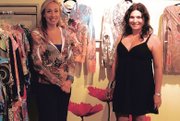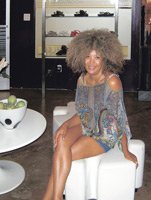Rearranging Spaces
Showroom owners turn to feng-shui practices to maximize their work spaces.
Apparel-showroom people are a creative bunch who are always trying to figure how to boost their sales. They send out postcards to buyers, attend trade shows, make cold calls and go on the road in hopes of garnering more business.
But a handful of showroom people in the Los Angeles Fashion District are taking an unconventional approach to improving their chances of success. They are calling in a feng-shui expert to analyze how color, light, furniture, plants, water fountains and metal racks can improve the flow of energy inside the showroom and attract more retailers.
“We made [a few] corrections and business went crazy,” said showroom owner Michael Cohen.
Nearly a decade ago, Cohen called in feng-shui expert Kartar Diamond to his showroom in The New Mart to make a few tweaks. Diamond asked him to put red gels in some of his ceiling lights to add warmth and position plants in the right location to add an earthy feel. A water fountain was added as well as other elements.
Cohen said within two or three years he had to add a 2,400-square-foot showroom on the 12th floor, in addition to his 1,200-square-foot showroom on the ninth floor, to accommodate his booming business. He has since moved his 12th-floor showroom to a new showroom, called Work in Progress, on the ninth floor because a large space opened up across from the elevators. That new space has also been arranged according to feng-shui principles.
Cohen got the idea to hire a feng-shui expert from Ronny Kleyweg, owner of the Animal House clothing store in Venice, Calif. Cohen walked into Kleyweg’s store one day nearly 10 years ago and noticed something had changed. “Hey, Ronny, your store looks awesome,” Kleyweg recalled Cohen saying.
Kleyweg, who has been in the same location for 25 years, informed Cohen that he had his store analyzed by Diamond, whom he had heard about through an acquaintance. “People instantly said, ’I don’t know what you did, but I feel good in here,’” Kleyweg said. “Within months, my business went up about 20 to 30 percent.”
So Cohen was convinced that feng shui would be a nice practice to apply to his business. After Cohen did his showroom, news spread among neighboring tenants. Desi Green, who used to work for Cohen, decided about seven years ago that she and her husband, Larry Balag, would feng shui their new Pulse Showroom in the Cooper Design Space.
“I had come out of a bad partnership and was coming into a good partnership,” Green said, explaining her decision to pay $400 for the advice, which is updated every year because energy changes as well as other elements. “We are just believers in good energy. What you give is what you get. I get paranoid about our energy, so I decided to feng shui,” Green noted.
Feng shui is based on a 3,000-year-old Chinese tradition that is the art and science of organizing space to be in harmony with its surroundings. Feng shui translated from Chinese into English means “wind-water,” emphasizing the yin and yang of the theory.
The theory incorporates various aspects of physics, geography, astronomy and other elements to increase the flow of chi, or the earth’s energy. When chi is blocked, weak or misdirected relationships, cash flow, creativity, health and careers can suffer.
Various tools are used that incorporate five basic elements, or energy types (earth, fire, wood, water and metal). The tools help direct chi to the right place.
“Anything with four walls and a ceiling can be assessed,” said Diamond, a feng-shui expert who has consulted with several showroom owners and other businesses. “I once feng shui-ed a tire shop in Torrance [Calif.].”
Feng shui is quite specific to the location. “A row of showrooms facing the same direction are similar,” Diamond said.
Diamond comes in with a compass to get the geographical reading of the showroom or space being analyzed. She takes into account the year a building was constructed. “A building’s feng shui is determined by the energy coming from the earth below when it was built and the position of the stars above,” she explained.
Diamond, who has been practicing for 17 years, also considers the birth dates of the showroom owners and their employees as well as the layout of the space. “When I go to a showroom, I look at the entrance. Is it attracting or repelling people? I look at where the showroom owners are sitting and where they are spending their day. Then I look at the placement of their inventory and the colors,” Diamond said.
Diamond superimposes her calculations over the floor plan to show what kind of unseen influences exist in the different directional areas of the space. Each directional area is composed of combinations of energy. The unbalanced spaces require the addition of one or two of the five elements of water, wood, fire, earth and metal to correct the imbalance.
Diamond has applied feng-shui principles to a handful of showrooms in the California Market Center. Most are on the fifth floor. Liza Stewart had her showroom feng shui-ed at the beginning of the year after being in her current showroom for two years. “I figured it couldn’t hurt,” Stewart said. “Actually, something did occur right after Kartar [Diamond] was here. A very promising account walked in and wrote a record-volume order.”
Stewart heard about feng shui from her CMC neighbors Mary Cesario-Sofio and Haley Miller, the owners of the Hale Mary showroom. They had Diamond work on their first showroom on the fifth floor, and she just completed a reading of their new showroom, a few doors down on the fifth floor. “I have two fountains behind me on the wall, and I have another fountain kittycorner. We had to have red on two walls and then we had to counterbalance in our back storage room, so that also has a red wall,” Cesario-Sofio said.
She noted they had to move the entranceway of their new showroom because the original entranceway was in an area that wouldn’t attract many customers. “We told the leasing people we wouldn’t take the space if the door wasn’t moved,” Cesario-Sofio said. “I think I sounded like a wack job.”























